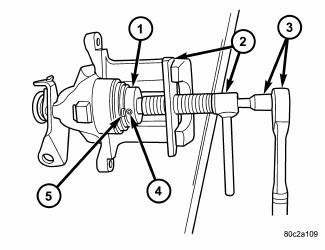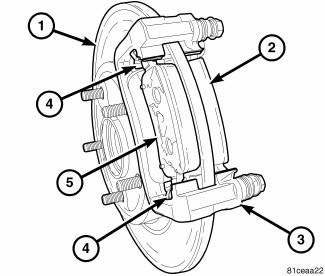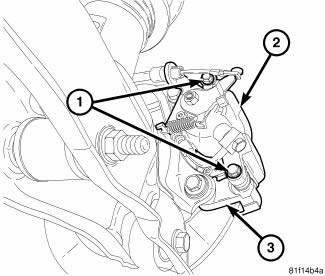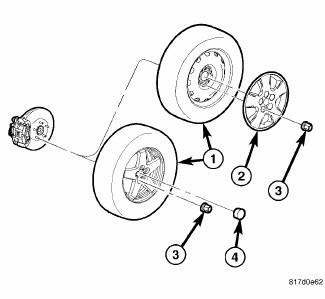Dodge Journey: Installation
NOTE: Perform 1 through 6 on each side of vehicle to complete pad set installation, then proceed to 7.
CAUTION: Anytime the brake rotor or brake pads are being replaced, the rear caliper piston must be seated (bottomed) to compensate for the new brake rotor or lining. Because the parking brake self-adjuster mechanism is attached to the piston, a special seating method is required. The only acceptable method is by rotating the piston back into the bore using Retractor, Special Tool 8807, as described below. Any other seating method will damage the self-adjuster mechanism.

Fig. 128: SEATING PISTON WITH SPECIAL TOOL
1. If necessary, seat (bottom) the caliper piston in the bore as follows:
- Assemble a 3/8 in. drive ratchet handle and an extension (3).
- Insert the extension through Special Tool 8807-1 (2).
- Place Special Tool 8807-2 (1) on the end of the extension.
- Insert lugs on Special Tool 8807-2 into notches in face of caliper piston (5).
- Thread the screw drive on 8807-1 down until it contacts the top of 8807-2 which is against the caliper piston. Do not over tighten the screw-drive. Damage to the piston can occur.
- Turn 8807-2 with the ratchet, rotating the piston in a clockwise direction until fully seated (bottomed) in the bore. It may be necessary to turn 8807-1 with 8807-2 to start the process of piston retraction.

Fig. 129: REAR BRAKE PADS
2. Make sure abutment shims (4) are in place on both upper and lower slide abutments of caliper adapter (3).
NOTE: If the brake pads have a protective paper on the rear face of the brake pad plate, it must be removed before pad installation.
3. Place the brake pads (2, 5) in the abutment shims (3) clipped into the disc brake caliper adapter bracket (3) as shown.

Fig. 130: REAR CALIPER MOUNTING
CAUTION: Use care when installing the caliper (2) onto the adapter bracket to avoid damaging the guide pin boots.
4. Install the disc brake caliper (2) over the brake pads on the brake caliper adapter bracket (3).
CAUTION: When removing or installing a caliper guide pin bolt, it is necessary to hold the guide pin stationary while turning the bolt. Hold the guide pin stationary using a wrench placed upon the pin's hex-shaped head.
5. Align the caliper guide pin bolt holes with the adapter bracket. Install the upper and lower caliper guide pin bolts (1). Tighten the guide pin bolts to 35 N.m (26 ft. lbs.).

Fig. 131: TIRE AND WHEEL MOUNTING
6. Install tire and wheel assembly (1). Install and tighten wheel mounting nuts (3) to 135 N.m (100 ft. lbs.).
7. Lower vehicle.
8. Pump brake pedal several times to ensure vehicle has a firm brake pedal before moving vehicle.
9. Check and adjust brake fluid level as necessary.
10. Road test vehicle and make several stops to wear off any foreign material on brakes and to seat brake pads.
 Removal
Removal
1. Raise and support vehicle.
NOTE: Perform 2 through 5 on each side of vehicle to complete pad set
removal.
Fig. 124: TIRE AND WHEEL MOUNTING
2. Remove wheel mounting nuts (3), then tire ...
See also:
Indicators
Indicators are located in various positions within the CCN and are all
connected to the CCN electronic circuit
board. All indicators, except the inverter indicator (if equipped), are
controlled b ...
Diagnosis and testing
BATTERY
The battery must be completely charged and the terminals should be properly
cleaned and inspected before
diagnostic procedures are performed. See Cleaning for the proper battery
cleaning ...
Draincock, radiator
Removal
DRAINCOCK
Fig. 65: DRAINCOCK & RADIATOR TANK
CAUTION: Use of pliers on draincock is not recommended. Damage may
occur to
radiator or draincock.
NOTE: It is no ...

